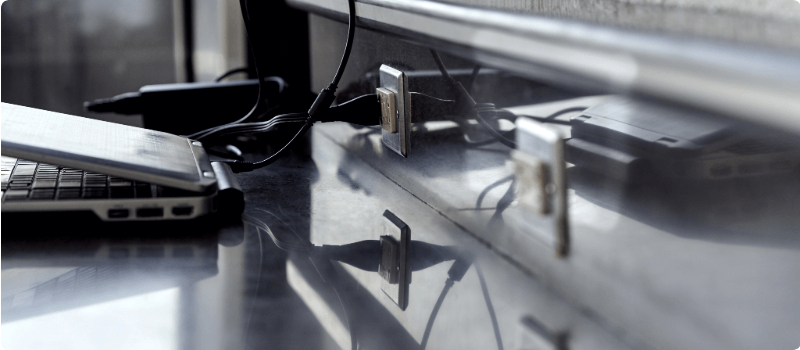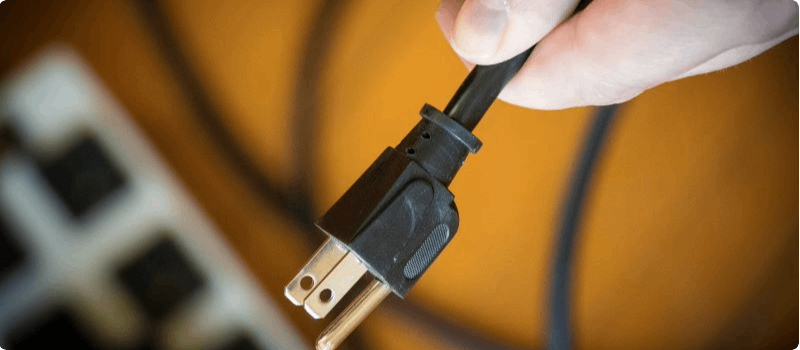Power Surges & Homeowners Insurance
Updated April 2, 2020 . AmFam Team
Homeowners insurance policies — specifically personal property coverage — generally cover damage to electronics and appliances caused by a power surge — but it depends on how the power surge happened.
Knowing how power surges occur is important to understand in order to protect yourself from one. We’ll walk you through what you need to know about power surges and insurance, as well as proactive steps you can take to protect your electronics and appliances from the damage they cause.

What is a power surge?
A power surge is a sudden spike or interruption in a home’s electrical grid that can overload or damage appliances or electronics in a home. A power surge usually occurs very quickly — lasting less than a thousandth of a second.
Power surges are caused by switching surges — originating from your home’s electrical grid — or by external factors that damage your home’s electrical grid, such as lightning or downed power lines.
Power surges caused by switching surges occur due to the following:
- Overloading outlets
- Damaged wiring
- High-powered devices
- Power outages

How does my home insurance cover power surge damage?
Standard homeowners insurance policies usually provide protection for covered events under your personal property coverage, up to your policy limit. So, if a covered event causes a power surge and damages or destroys your appliances or electronics, your personal property coverage may help cover the cost to repair or replace them. But whether you’re covered depends on your specific policy and insurance provider, so it’s important to understand the terms and limits of your coverage when it comes to power surge insurance. A great way to do this is by scheduling a personal insurance review with your agent. They can walk you through everything you need to know in your policy to gain confidence in your coverage.
There are some exclusions on your policy for whether or not you’ll be covered for a power surge, so if you want peace of mind that your electronics have protection, no matter the cause of the power surge, you can add equipment breakdown coverage. This coverage offers protection for the following items if they’re damaged due to mechanical, electrical or pressure systems:
- Appliances
- Home systems
- Smart home devices

Equipment breakdown coverage helps protect you from paying for expensive repair or replacement costs after a power surge.
So, while your standard home insurance policy does cover lightning damage, as well as damage from artificially generated electrical current, having equipment breakdown coverage means there are no per-item limits and there is a lower deductible. Find out more about equipment breakdown coverage.

Items Usually Covered by Homeowners Insurance
Your home insurance typically covers power surge damage to the following items:
Appliances
If your appliances, like washing machine or fridge, face power surge damage, you should be covered under your personal property coverage on your homeowners insurance policy.
Electrical Items
The dwelling coverage on your policy typically covers your home’s wiring if it’s damaged by a power surge.

Electronics
Similar to your appliances, if your electronics, like a computer or TV, are damaged by a power surge, you can usually depend on your personal property coverage to help repair or replace the damaged item.
With American Family Insurance, your basic homeowners insurance policy covers up to $1,200 per item of personal property (subject to your overall personal property limit). Adding equipment breakdown coverage enhances your coverage by replacing that per-item limit with a $100,000 total limit.

Power Surge Damage Insurance Claim Process
If you experience damage from a power surge, you can submit a claim with your insurance company to recover from those losses. Be proactive and create an inventory of the electronics (and other personal property) in your home in case you do need to file a claim. Not only will this help you determine that you have the right amount of coverage, but it’ll make filing a claim easier, too.
Here’s what to do when filing a power surge claim:
1. Assess the damage that was sustained as soon as it’s safe to do so
The insurance claims adjuster will need to know what damage occurred, so be thorough and write down everything that happened, including the date and time of the incident.
2. File a claim with your insurance provider
At American Family Insurance, you can file your claim online, by contacting your agent or by calling 1-800-MYAMFAM (1-800-692-6326). You can also file through My Account or the MyAmFam app.
3. Consider your deductible
You’ll likely have to pay a deductible before your insurance covers the cost. If the cost to repair or replace the damaged property is more than your deductible, you can choose to continue with the claims process and your adjuster will work with the insurance company to determine a settlement for repairs.
4. Get paid
Once your claim has been accepted, you’ll receive a check — or checks — to repair or replace your damaged property.

How to Prevent Power Surge Damage: Safety & Protection Tips
Taking proactive steps to protect your home from power surges is a smart move as a homeowner. Simple safety measures can go a long way. Here are a few safety tips to prevent power surges:
Unplug the electronics and devices you aren’t using. Not only does this help prevent them from being damaged in a power surge, but it also helps you save on your energy bill.
Unplug electronics during a storm. Make sure to unplug your electronics during a storm to prevent them from being affected by a power surge caused by lightning.

Use surge protectors. Plug your electronics into surge protectors. These help block excess voltage from reaching your electronics during a power surge.
Upgrade old or inadequate wiring. If you’re noticing frequently blown fuses or tripped circuit breakers, or if the lights flicker or dim when a large appliance kicks on, you may have bad wiring. That type of damage could cause a power surge or a fire.
Power surges are caused by the unexpected — but with American Family Insurance, you’re prepared. Get an American Family Insurance quote today for power surge home protection.
Tools & Resources
NextScripts
JSS component is missing React implementation. See the developer console for more information.

